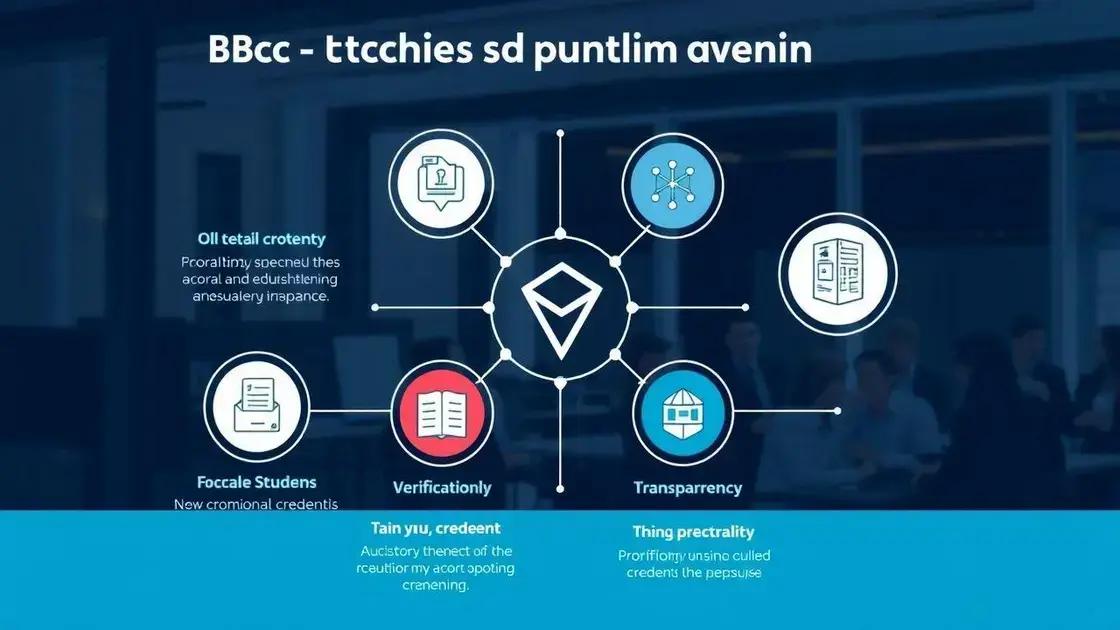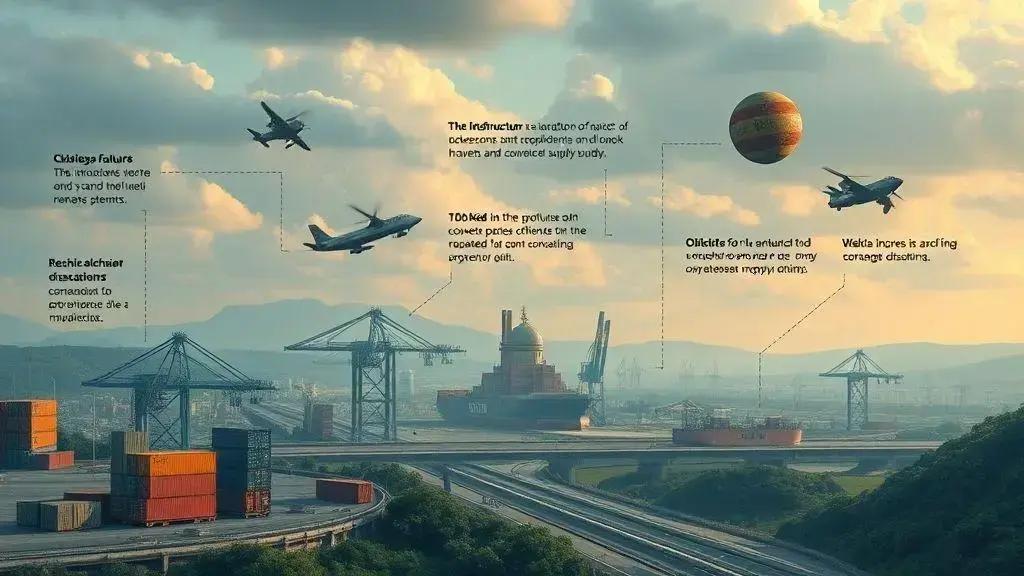Blockchain verification for federal supply chains: a game changer
Blockchain verification for federal supply chains enhances transparency, security, and efficiency while addressing challenges like interoperability and regulatory compliance, making it a vital technology for modern logistics.
Blockchain verification for federal supply chains is emerging as a powerful tool to enhance transparency and security. But how does it really work, and what does it mean for government operations? Let’s dive in.
Understanding blockchain technology and its features
Understanding blockchain technology is crucial to grasp how it can transform supply chains. At its core, blockchain is a decentralized digital ledger that records transactions across many computers. This technology makes it nearly impossible to alter or hack the system, ensuring a high level of security.
A major feature of blockchain technology is its transparency. Every transaction on the blockchain is visible to all participants in the network. This openness helps build trust among stakeholders because it allows for easy verification of transactions. Another essential aspect of blockchain is its immutability. Once a transaction is recorded, it cannot be changed or deleted, providing a permanent record.
Key features of blockchain technology
Some key features that make blockchain an appealing choice for federal supply chains include:
- Decentralization: No central authority controls the data, reducing risks of fraud.
- Efficiency: Smart contracts on the blockchain can automate processes, speeding up transactions.
- Traceability: The digital records allow for tracking of goods at each stage of the supply chain.
- Security: Advanced cryptography protects data from unauthorized access.
These features make blockchain a powerful tool for enhancing efficiency and reliability in federal supply chains. When we talk about the adoption of blockchain technology, we should also note that it can facilitate better collaboration. By sharing data in real time, agencies can respond quickly to issues and make more informed decisions.
Furthermore, integrating blockchain into existing systems is becoming increasingly possible. Many companies are working on solutions that bridge traditional systems with blockchain, allowing for a smoother transition and enhanced functionalities. This adaptability means that blockchain can evolve alongside emerging technologies, enhancing its potential applications in the federal sector.
As we explore blockchain, it’s clear that understanding its features is just the beginning. The potential benefits for federal supply chains can revolutionize how agencies operate, providing them with tools that improve operations and accountability.
Benefits of blockchain verification in supply chains

Benefits of blockchain verification in supply chains are significant, offering multiple advantages to federal agencies. One of the most crucial benefits is the enhanced transparency. Every transaction recorded on the blockchain can be viewed by all involved parties. This level of openness reduces the chances of fraud and provides clarity in the logistics process.
Another major benefit is improved efficiency. With blockchain technology, processes that usually take days can be streamlined. Smart contracts can automate various tasks, allowing for quicker transactions. This automation not only saves time but also minimizes human error.
Key advantages of using blockchain verification
Some of the top advantages that organizations can reap include:
- Traceability: All products can be tracked throughout the supply chain, ensuring accountability.
- Cost savings: By eliminating intermediaries and automating processes, companies can reduce operational costs.
- Enhanced security: Blockchain’s cryptographic features protect sensitive data and ensure that records are tamper-proof.
- Collaboration: Agencies can easily share information in real-time, leading to better decision-making.
By leveraging these benefits, federal supply chains can achieve remarkable transformations. Opting for blockchain verification fosters a culture of trust among stakeholders, which is vital for collaborations. Trust leads to stronger partnerships between agencies and suppliers.
Moreover, as compliance requirements continue to grow, blockchain can play a pivotal role in helping agencies maintain regulatory standards. With each transaction locked securely on the blockchain, agencies can easily present records for audits or compliance checks, making the entire process more seamless.
In summary, the adoption of blockchain verification in supply chains not only streamlines operations but also enhances overall productivity, making it a necessary consideration for government agencies.
Real-world applications of blockchain in federal logistics
Real-world applications of blockchain in federal logistics demonstrate how this technology is changing the way government agencies operate. By utilizing blockchain, agencies can enhance supply chain transparency and improve the overall efficiency of logistics operations.
One notable application is in tracking shipments. With blockchain, every movement of goods can be logged in real-time. This capability allows agencies to monitor shipments and respond swiftly to any discrepancies. For example, if a package is delayed or misplaced, stakeholders can quickly identify where the issue occurred.
Key use cases in federal logistics
Several federal agencies are already exploring blockchain applications:
- Defense Logistics: The Department of Defense uses blockchain to track the movement of critical materials and equipment. This ensures that all items are accounted for and helps prevent fraud.
- Food Safety: The USDA uses blockchain to ensure food products are traceable from farm to table. This transparency helps in recalling products and ensuring public safety.
- Inefficiencies in Payment Processing: Blockchain can simplify payment transactions between federal contractors and the government, reducing delays and errors.
As we look at these examples, it’s clear that blockchain technology is proving to be a valuable asset. It enhances data integrity, as records are immutable and can be trusted. Each entry on the blockchain creates a complete history of transactions, which can be reviewed at any time.
Furthermore, the integration of blockchain with other technologies like IoT (Internet of Things) enhances logistics capabilities. For instance, sensors on shipments can feed real-time data onto the blockchain, allowing for better decision-making and operational efficiency.
Agencies continue to investigate new ways to implement blockchain, making logistics more efficient while ensuring accountability and security. The growing interest shows promise for future developments and the potential for even broader applications in the federal logistics sector.
Challenges and future of blockchain adoption in government supply chains

Challenges and future of blockchain adoption in government supply chains are significant topics as agencies explore this transformative technology. While the benefits of blockchain are clear, several challenges hinder its widespread adoption.
One major challenge is the lack of understanding about blockchain technology. Many government officials may not fully grasp how blockchain works or its potential benefits. This knowledge gap can lead to hesitation in implementation, resulting in missed opportunities for improved operations.
Key challenges government agencies face
Some of the key challenges include:
- Interoperability: Existing systems in government may not easily integrate with blockchain technology. Adjusting old infrastructures can be costly and time-consuming.
- Regulatory concerns: Agencies must navigate regulations surrounding data privacy and security, which can complicate blockchain implementations.
- Initial costs: Setting up blockchain infrastructure requires investment, and budgets may be limited, especially in governmental contexts.
- Stakeholder resistance: Some stakeholders may resist change, preferring traditional processes over adopting new technologies.
Despite these challenges, the future of blockchain in government supply chains looks promising. As awareness increases, more agencies are likely to explore the technology’s potential. Improvement in education around blockchain can address misunderstandings and build confidence among decision-makers.
Additionally, collaborations between government and private sectors can help develop tailored solutions that meet specific needs. Partnerships can also assist in overcoming interoperability issues by creating standards that facilitate smoother transitions to blockchain systems.
As advancements in technology continue, we may see more innovative applications of blockchain emerge. These developments could lead to enhanced security and efficiency in government supply chains, ultimately benefiting public services.
FAQ – Frequently Asked Questions about Blockchain in Federal Supply Chains
What are the main benefits of using blockchain in supply chains?
The main benefits include enhanced transparency, improved efficiency, and increased security, helping to streamline operations and build trust among stakeholders.
What challenges do agencies face when adopting blockchain technology?
Agencies often face challenges such as lack of understanding, interoperability with existing systems, regulatory compliance, and initial costs of implementation.
How can blockchain improve transparency in logistics?
Blockchain allows for real-time tracking of shipments, providing all parties access to the same information, which reduces the chances of fraud and errors.
What is the future outlook for blockchain in government logistics?
The future looks promising, with potential for improved collaboration between public and private sectors to develop tailored solutions and address logistical challenges.





